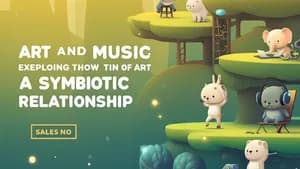Performance art is a captivating art form that pushes the boundaries of traditional artistic disciplines. It's a vibrant fusion of music, visual art, theater, and dance, where artists utilize their bodies, voices, and environments to create immersive experiences. The beauty of performance art lies in its ability to transcend the limitations of static mediums, inviting audiences to engage with the art in a visceral and immediate way.
The Power of Music in Performance Art
Music plays a crucial role in shaping the emotional landscape of performance art. It's not merely a background accompaniment but a powerful tool that can evoke a wide range of feelings, from joy and excitement to sorrow and introspection. The careful selection and manipulation of music can transform a simple gesture or movement into a powerful statement. Imagine a performance where a dancer expresses the fragility of life through subtle movements, underscored by a haunting melody. The music acts as a catalyst, amplifying the emotions conveyed by the dancer's body.
Remember, music is a language that speaks to our deepest emotions. As a student, you can learn to appreciate music's role in performance art by actively listening to the soundtracks used in different performances. Consider how the music builds tension, creates a sense of peace, or triggers a specific emotion. This active listening will enhance your understanding and appreciation of the artistic choices made by the performer.
The Visual Art of Performance
While music provides the soundtrack to performance art, visual art serves as the stage for the artist's expression. The visual elements of a performance can range from simple costumes and props to elaborate sets and multimedia projections. The way artists use their bodies, movements, and the physical space around them becomes a form of visual art. Think of a performance where a dancer uses their body as a canvas, creating intricate patterns with their movements. The dancer's body language, combined with the music, tells a story without the need for spoken words.
Don't underestimate the impact of the visual aspect. It's not just about what you see, but how you interpret it. Pay attention to the colors, lighting, and even the way the space is used. These elements can add depth and meaning to the performance. For example, a performance set in a stark white space might evoke feelings of isolation, while a performance using vibrant colors might create a sense of celebration.
The Interplay of Sound and Image
The true magic of performance art lies in the seamless integration of music and visual art. The two elements work in harmony, complementing and enhancing each other. This interplay between sound and image can create a truly unforgettable experience. Think about a performance where a musician plays a melancholic piece, while a dancer uses their body to illustrate the emotions expressed in the music. The music and the visual elements work together to create a unified narrative, allowing the audience to experience the performance on a deeper level.
As a student, try to pay attention to how the music and visuals interact during a performance. Are the movements synchronized with the music? Does the visual aesthetic amplify the emotional impact of the music? By actively observing these elements, you will gain a greater understanding of the artist's creative process and their intentions.
Engaging with Performance Art
Performance art is an interactive experience that invites audiences to participate in the artmaking process. The artist doesn't simply present a finished product; they engage with the audience in real-time, creating a shared experience. This immediacy and engagement can be both exhilarating and thought-provoking. Remember, you're not just a passive observer. You're part of the art experience. Feel free to respond to the performance. Your reactions, emotions, and even your silence become part of the overall artwork. Engage with the performance, let it move you, and allow yourself to be transported by the artist's vision.
Conclusion
Performance art is a dynamic art form that continues to push boundaries and challenge our perceptions. It's a space where music and visual art intertwine, creating an immersive and unforgettable experience. The next time you have the opportunity to see a performance art piece, remember to engage with the art on multiple levels. Listen to the music, pay attention to the visuals, and allow yourself to be moved by the artistry of the performer. You'll discover a world of creativity and expression that is both inspiring and thought-provoking.
Performance art isn't just about entertainment; it's about engaging with ideas, challenging norms, and expanding our understanding of the world around us. As a parent, encourage your child to explore this art form. It's a fantastic way to foster creativity, broaden perspectives, and develop a deeper appreciation for the arts.

